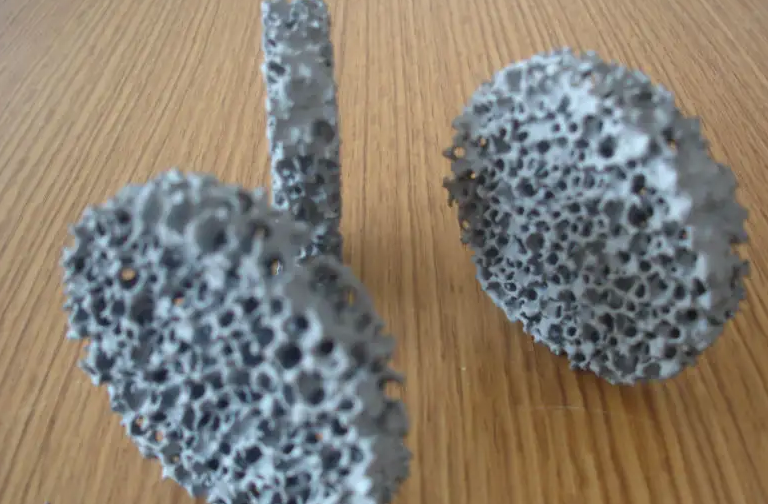Copper foam is a different kind of multifunctional material with a large number of connected or disconnected holes uniformly distributed on the copper matrix. Copper foam has excellent electrical conductivity and ductility. Compared with nickel foam, copper foam has low preparation cost and excellent electrical conductivity. It can be used to prepare cathode (carrier) materials for batteries, catalyst carriers and electromagnetic shielding materials. In particular, foamed copper has some obvious advantages as a base material for battery electrodes, but its corrosion resistance is not as excellent as nickel, which limits some of its applications.
Nickel foam is a kind of sound absorbing material with excellent performance. It has strong sound absorption coefficient at high frequency. By designing sound absorption structure, the sound absorption performance at low frequency can be improved.
High temperature resistance of nickel bubbles under inert atmosphere
Its peculiar open-hole structure, low pressure input hole, inherent tensile strength and thermal impact performance, make nickel foam highly likely to be the catalyst carrier of automotive catalyst converters, catalytic burners, diesel vehicle black smoke purifiers. In the process of carbon monoxide and hydrocarbon conversion during engine cold start, the performance of nickel foam catalyst support may be better than that of ceramic catalyst support due to its thermal conductivity. In this sense, the performance of nickel foam catalyst support may be better than or better than that of high temperature resistant steel catalyst support. Additional applications include Fisher-Topsh reaction, gas modification, hydrogenation of fine chemicals and additional nickel foam catalyst supports.
 Foamed copper has excellent mechanical and processing properties, excellent electrical and thermal conductivity, and a large number of three-dimensional pore structures inside the material. At the same time, the copper itself has alkali corrosion resistance, excellent tensile strength and ductility, and has excellent electromagnetic shielding and sound attenuation and shock absorption. Suitable for CPU, graphics card, LED and other electronic components heat dissipation and heat exchange materials, phase shift energy storage materials, cushioning structure materials, lithium ion or fuel cell electrode materials, silencing materials, electromagnetic shielding materials, building materials, all kinds of metal foam filter filters, catalysts and carriers.
Foamed copper has excellent mechanical and processing properties, excellent electrical and thermal conductivity, and a large number of three-dimensional pore structures inside the material. At the same time, the copper itself has alkali corrosion resistance, excellent tensile strength and ductility, and has excellent electromagnetic shielding and sound attenuation and shock absorption. Suitable for CPU, graphics card, LED and other electronic components heat dissipation and heat exchange materials, phase shift energy storage materials, cushioning structure materials, lithium ion or fuel cell electrode materials, silencing materials, electromagnetic shielding materials, building materials, all kinds of metal foam filter filters, catalysts and carriers.
Structural Advantages of metal foam in sand control screens?
Metal foam is made of metal and gas composite, which contains a certain amount of metal in the metal matrix, has a certain size pore size and a certain porosity, and has excellent filtration performance. It is a feasible scheme to develop a special screen tube with metal foam as sand retaining medium.
The sand retaining effect of sand control screen mainly depends on the structure and specification parameters of sand retaining medium.
In order to optimize the structure parameters of metal foam sand retaining medium and guide the design of sand control screen, the performance test of metal foam sand retaining with different structure parameters and specification parameters was carried out by using the laboratory core displacement simulation test bench, and the effect of metal foam sand retaining with different arrangement structure and thickness ratio was analyzed. The RESULTS SHOW THAT THE VARIABLE pore size structure OF sand retaining medium in mortar with "dense outside and sparse inside" is better than that of uniform single pore size structure, and has better ANTI-clogging performance, and the advantage is more obvious with the increase of sand discharge.
At 100 mL/min, the pressure difference of variable pore size displacement is about 40% lower than that of uniform single pore size displacement. The displacement ability of different foam metal thickness ratios is also different. The displacement pressure difference of 2:3 structure is about 15% lower than that of 2.5:2.5 structure, and the sand control amount is about 2.6 times lower than that of 1.5:3.5 structure. As sand control screen type sand retaining medium, metal foam has variable pore size structure and thickness ratio of 2:3, which can meet the needs of oil and gas field development and completely consider the influence of displacement pressure difference, sand discharge and sand discharge. It provides a theoretical reference for further optimization of sand control screen structure.